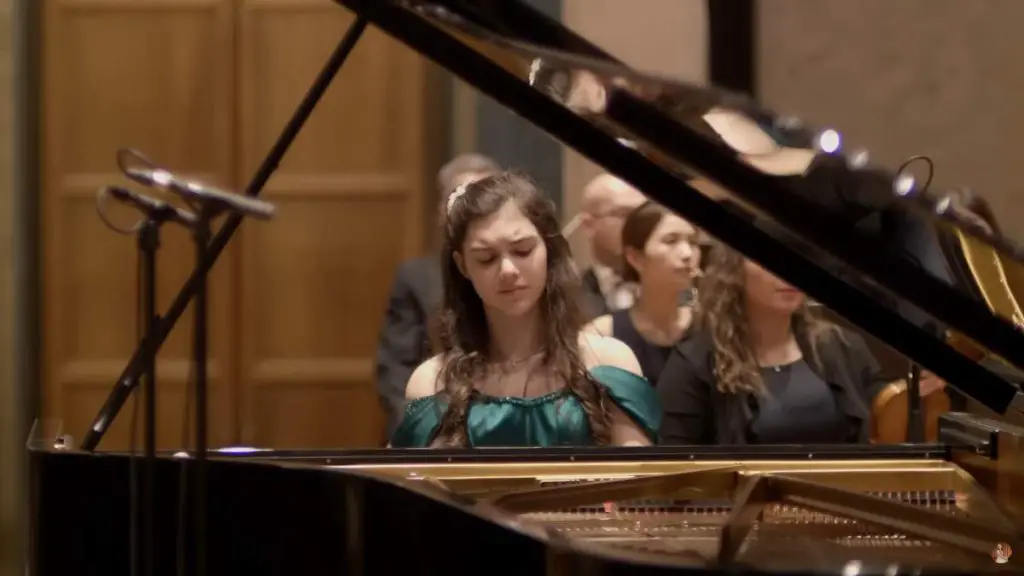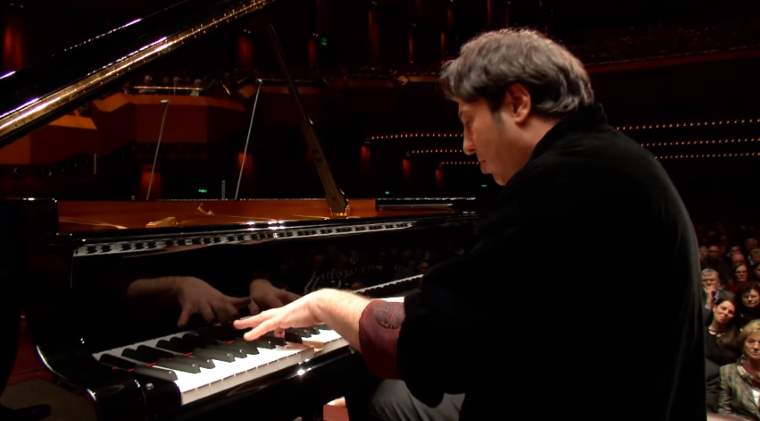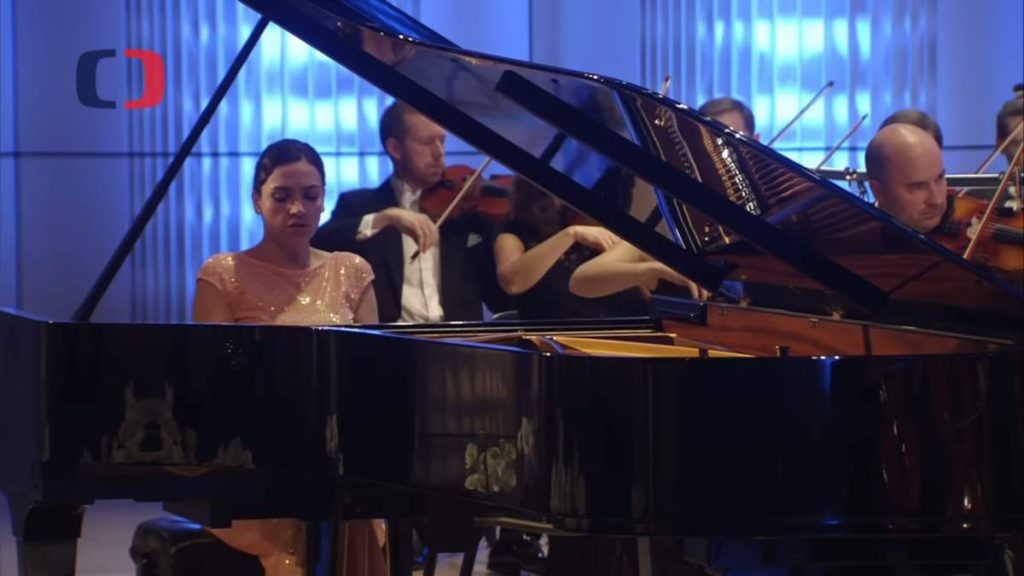Accompanied by the Klassische Philharmonie Bonn Orchestra, the Turkish pianist İlyun Bürkev performs Ludwig van Beethoven’s Piano Concerto No. 3 in C minor, Op. 37. Conductor: Alexander Hülshoff. This performance was recorded at the Munich Herkules Hall on October 25, 2023, when Bürkev was only 15 years old!
Beethoven’s Piano Concerto No. 3
Beethoven’s Piano Concerto No. 3 in C minor, Op. 37, is a work that showcases the composer’s evolving style and mastery in blending the piano with an orchestral ensemble, marking a significant development in the piano concerto genre. Composed in the early 1800s, specifically around 1800-1803, this concerto is Beethoven’s venture into a more dramatic and expressive form, a departure from the more classical compositions inspired by his predecessors like Mozart and Haydn.
This concerto is noted for its emotional depth and technical complexity, reflecting Beethoven’s own challenges and innovations as a composer who was gradually losing his hearing. The choice of C minor, a key Beethoven often associated with heroic struggle, adds to the concerto’s intensity and depth. It premiered on April 5, 1803, with Beethoven himself playing the solo piano part, a testament to his virtuosity and direct connection to his work.
The Piano Concerto No. 3 is significant not only for its musical content but also for its place in Beethoven’s career. It represents a bridge between the Classical and Romantic eras of music, incorporating the structural clarity and balance of the former with the expressive power and individualism of the latter. This blend of elements contributes to the concerto’s enduring popularity and critical acclaim, making it a staple of the piano concerto repertoire.
Furthermore, the work is an example of Beethoven’s innovative approach to composition, particularly in how the solo piano interacts with the orchestra. Rather than merely accompanying the soloist, the orchestra engages in a dialog, creating a more integrated and dynamic relationship between the piano and the ensemble. This interaction paved the way for the future development of the concerto form, influencing generations of composers who followed Beethoven.
Movements
1. Allegro con brio
The first movement of Beethoven’s Piano Concerto No. 3 in C minor, Op. 37, is marked as Allegro con brio, which translates to “fast with vigor.” This movement serves as a powerful opening to the concerto, immediately setting the tone for the dramatic and emotional depth that characterizes the entire work. The Allegro con brio is notable for its expansive structure, sophisticated development, and the dynamic interplay between the solo piano and the orchestra.
The movement begins with an orchestral exposition, where the main themes are introduced by the orchestra, presenting a wide range of musical ideas that the piano will later develop and elaborate upon. This is followed by the entrance of the solo piano, which not only recapitulates the themes presented by the orchestra but also introduces new material, showcasing the soloist’s virtuosity and interpretative depth.
A significant feature of this movement is the development section, where Beethoven demonstrates his mastery in manipulating and transforming musical themes. The interaction between the piano and the orchestra intensifies, highlighting a conversation-like dialogue that was innovative for its time. This section explores a variety of harmonic and thematic possibilities, adding to the movement’s emotional intensity and complexity.
The recapitulation brings back the main themes, now enriched and deepened by their developmental journey. The movement concludes with a cadenza for the solo piano, offering the soloist an opportunity to display technical brilliance and personal expression before the final orchestral coda. Originally, Beethoven did not write down the cadenza, leaving it to the performer’s improvisation. However, he later composed cadenzas for this concerto, and today performers typically choose between Beethoven’s written cadenzas or those by other composers or even their own.
2. Largo
The second movement of Beethoven’s Piano Concerto No. 3 in C minor, Op. 37, is marked Largo and is a striking contrast to the dramatic and vigorous first movement. This Largo unfolds as a serene, expansive, and deeply expressive adagio that showcases Beethoven’s ability to convey profound emotional depth through simplicity and elegance.
Set in E major, which stands in stark contrast to the tumultuous C minor of the first movement, the Largo offers a moment of repose and reflection. The key choice here is particularly noteworthy; E major is relatively distant from C minor in terms of tonal relationships, which contributes to the movement’s distinct and almost ethereal character. This shift in tonality creates an oasis of calm, allowing for a display of lyrical beauty and introspection.
The movement opens with a soft and tender theme introduced by the strings, setting a tranquil and contemplative mood. The piano enters delicately, weaving its own voice into the orchestral tapestry with lines that are both expressive and introspective. The interaction between the piano and the orchestra in this movement is characterized by a gentle dialogue, with the piano part often mirroring or subtly elaborating on the orchestral themes.
Throughout the Largo, Beethoven explores a rich palette of harmonic colors, creating a warm and enveloping sound world. The music flows gracefully, with each phrase carefully crafted to convey a sense of deep emotional resonance. The overall structure of the movement, while maintaining a sense of formal balance, serves primarily to highlight the expressive and lyrical qualities of the music.
One of the defining features of this movement is its use of space and silence. Beethoven employs these elements to enhance the music’s expressive power, allowing the listener to fully absorb and reflect upon the beauty of the melodies and harmonies. The Largo concludes gently, fading away into a peaceful resolution that prepares the listener for the energetic finale of the concerto.
3. Rondo: Allegro
The third movement of Beethoven’s Piano Concerto No. 3 in C minor, Op. 37, marked as Rondo: Allegro, serves as a vivacious and spirited finale to the concerto. This movement is characterized by its lively tempo, rhythmic energy, and the return to the dramatic and somewhat turbulent mood of the first movement, though it carries a noticeably more optimistic tone.
Structured as a rondo, this movement follows a recurring theme format (ABACABA), where the main theme (A), known for its catchy and rhythmic nature, alternates with contrasting sections (B and C). The rondo form allows Beethoven to explore a variety of musical ideas while maintaining a cohesive and unified structure, leading to a dynamic and engaging conclusion to the concerto.
The main theme is memorable for its rhythmic drive and forward momentum, featuring a playful and almost dance-like character. This theme is introduced by the piano and is then echoed and developed by the orchestra, creating a lively and robust dialogue between the soloist and the ensemble. The contrasting sections introduce new melodic and harmonic material, adding depth and complexity to the movement while providing moments of contrast to the principal rondo theme.
The use of C minor for the finale adds to the overall coherence of the concerto, tying the three movements together through a shared tonal landscape. However, the mood in this final movement is far from somber; instead, it exudes a sense of triumph and joyous release, showcasing Beethoven’s skill in manipulating musical form and expression to convey a wide range of emotions.
One of the highlights of the Rondo: Allegro is the cadenza, a section typically designed for the soloist to showcase their virtuosity and interpretive skills without orchestral accompaniment. Beethoven wrote specific cadenzas for this movement, but performers sometimes chose to play cadenzas written by other composers or their own. The cadenza in this movement provides a dramatic highlight before the concerto moves towards its conclusion.
The movement culminates in a vigorous and exhilarating finale, with the main theme returning for one last statement, leading to a powerful and triumphant close. The orchestral forces join in full, reinforcing the piano’s final statement of the theme and bringing the concerto to an exuberant and satisfying conclusion.
İlyun Bürkev
İlyun Bürkev (born October 17, 2008, in İzmir, Türkiye) began her musical journey at the tender age of four and has since honed her skills under the guidance of esteemed educators. She started her formal training at the Istanbul Mimar Sinan University of Fine Arts State Conservatory with Prof. Burcu Aktas Urgun.
Currently, she is enhancing her expertise at the prestigious Mozarteum University Salzburg’s pre-college program, studying under Prof. Pavel Gililov, where she secured a first-degree position during the auditions. Bürkev’s exceptional talent has earned her accolades in various international piano competitions.

In August 2021, she showcased her prowess by performing Mozart’s Piano Concerto No.13 at the 18th Gümüslük International Music Festival’s finale, accompanied by the “El Ele Müzik Symphony Orchestra” and conducted by Nil Venditti. The following month, she delighted audiences with solo performances at the Ahmed Adnan Saygun Sanat Merkezi Art Center in Izmir and the Türkan Saylan Kültür Merkezi Cultural Center in Istanbul.
On October 22, 2021, Bürkev once again performed Mozart’s 13th Piano Concerto, this time with the Adana Cukurova State Symphony Orchestra under Eray Inal’s direction. Her performance as a soloist on October 29, Republic Day, at the Galataport Istanbul’s opening concert with the Dogus Children Symphony Orchestra, conducted by Rengim Gökmen, was memorable.
She continued her series of captivating performances with a piano recital at the Süreyya Opera House on January 16, 2022, and collaborated with state artist Gülsin Onay and Tuna Bilgin at the 17th International Bellapais Music Festival in Cyprus on April 25, 2022.
In May 2022, Bürkev performed Grieg’s Piano Concerto with the Ankara State Opera Orchestra and the Izmir State Symphony Orchestra. Her latest achievement came in January 2023, where she clinched the 3rd prize at the Jeune Chopin 3rd International Piano Competition in Lugano, Switzerland, a competition where no first place was awarded in her category.
Bürkev’s early introduction to the international music scene was marked by winning the 1st prize in the B category of the “Memorijal Jurica Murai” International Piano Competition in Varazdin, Croatia. She continued to impress with a series of first-place victories, including at the Istanbul Hisar Schools International Piano Competition.
Her accomplishments further include the 3rd prize at the Paris International Music Competition in July 2018, the 3rd prize at the Adana Rhapsody Piano Competition in April 2019, and the 1st prize at the Istanbul Pera International Piano Competition in May 2019. Additionally, she won the 1st prize in the Infantile A category of the 9th International Piano Competition María Herrero in Spain, receiving the “Special Prize for Musicality” award.
At the Chopin International Piano Competition organized by Maltepe University in Istanbul, she was honored with the 1st prize for Best Chopin Performance and Best National Piece Performance. Her continuous success in competitions, coupled with her captivating performances, underscores Bürkev’s growing prominence in the classical music world.
Sources
- Piano Concerto No. 3 (Beethoven) on Wikipedia
- Piano Concerto No.3, Op.37 (Beethoven, Ludwig van) on the International Music Score Library Project website
- Ludwig van Beethoven: Piano Concerto No. 3 on the L.A. Phil website



